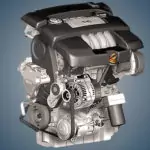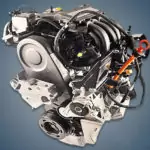The 1.2-liter Volkswagen CBZB 1.2 TSI engine was assembled by the concern from 2009 to 2015 and was installed on a number of company models, including those manufactured under the Audi, Skoda and Seat brands. There is a version of this power unit derated up to 90 hp under the index CBZC.
The EA111-TSI series includes: CBZA, CBZB, BMY, BWK, CAVA, CAVD, CAXA, CDGA, CTHA.
Specifications
| Production years | 2009-2015 |
| Displacement, cc | 1197 |
| Fuel system | direct injection |
| Power output, hp | 105 |
| Torque output, Nm | 175 |
| Cylinder block | cast iron R4 |
| Block head | aluminum 8v |
| Cylinder bore, mm | 71 |
| Piston stroke, mm | 75.6 |
| Compression ratio | 10.0 |
| Features | SOHC |
| Hydraulic lifters | yes |
| Timing drive | chain |
| Phase regulator | no |
| Turbocharging | IHI 1634 |
| Recommended engine oil | 5W-30 |
| Engine oil capacity, liter | 3.8 |
| Fuel type | petrol |
| Euro standards | EURO 5 |
| Fuel consumption, L/100 km (for VW Golf 2012) — city — highway — combined |
7.1 4.9 5.7 |
| Engine lifespan, km | ~240 000 |
The engine was installed on:
- Audi A3 2 (8P) in 2009 – 2013;
- Seat Altea 1 (5P) in 2010 – 2015;
- Seat Ibiza 4 (6J) in 2010 – 2015;
- Seat Leon 2 (1P) in 2010 – 2012;
- Seat Toledo 4 (KG) in 2012 – 2015;
- Skoda Fabia 2 (5J) in 2010 – 2014;
- Skoda Rapid 1 (NH) in 2012 – 2015;
- Skoda Roomster 1 (5J) in 2010 – 2015;
- Skoda Yeti 1 (5L) in 2009 – 2015;
- Volkswagen Beetle 2 (5C) in 2011 – 2014;
- Volkswagen Caddy 3 (2K) in 2010 – 2015;
- Volkswagen Golf 6 (5K) in 2009 – 2013;
- Volkswagen Golf Plus 1 (5M) in 2009 – 2014;
- Volkswagen Jetta 6 (1B) in 2010 – 2014;
- Volkswagen Polo 5 (6R) in 2009 – 2014;
- Volkswagen Touran 1 (1T) in 2010 – 2015.
Disadvantages of the VW CBZB engine
- The first year of production, the main problem of the motor was a very low resource of the timing chain.
- The updated chain runs about 100,000 km, but immediately jumps when stretched.
- The turbine geometry and wastegate control electric drive often fails.
- Also, this engine is famous for periodic vibrations at idle.
- Another disadvantage is the very long warm-up of the engine in the cold season.






